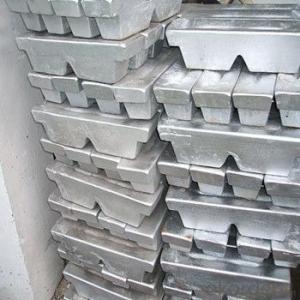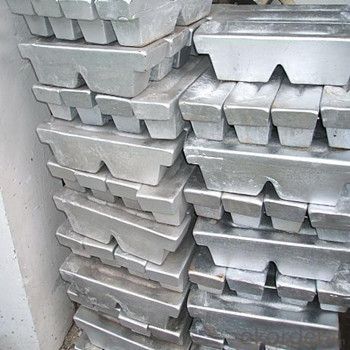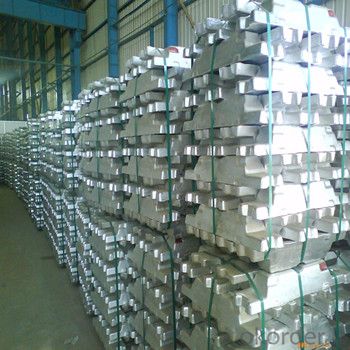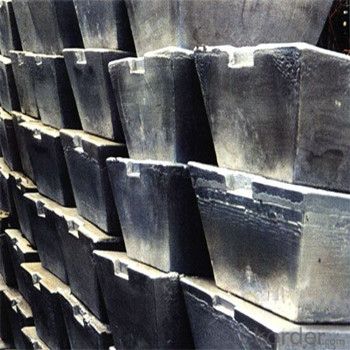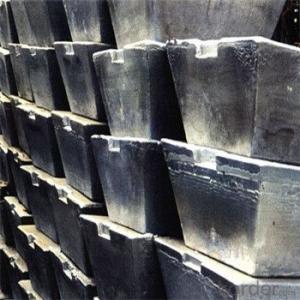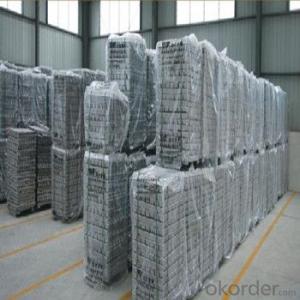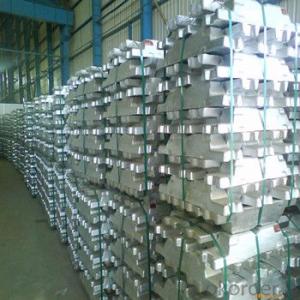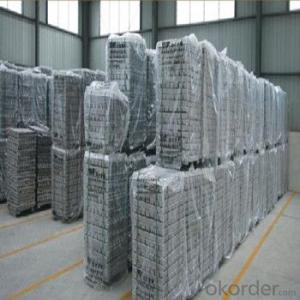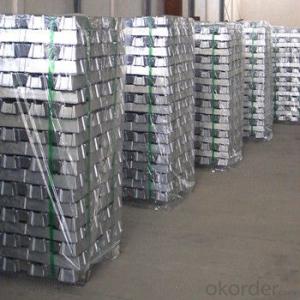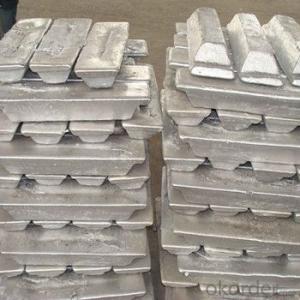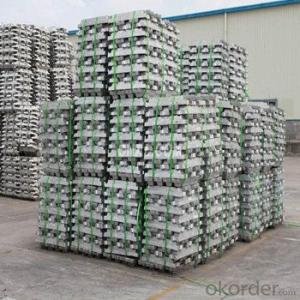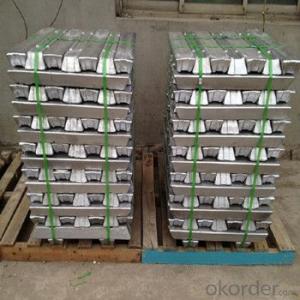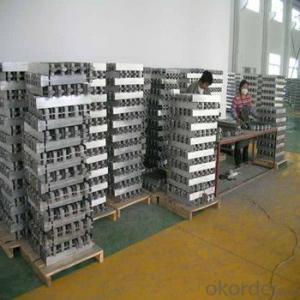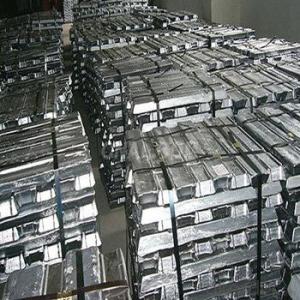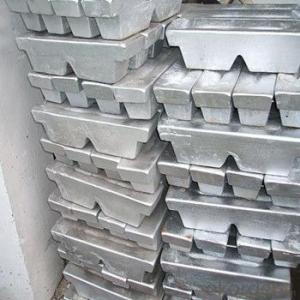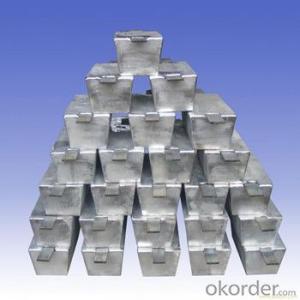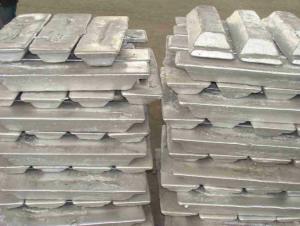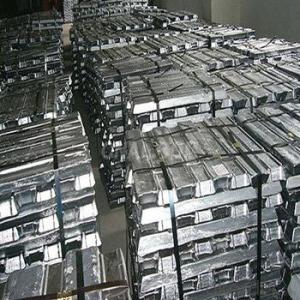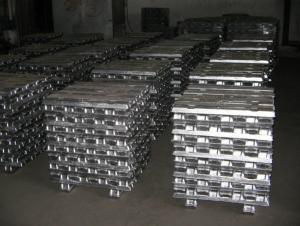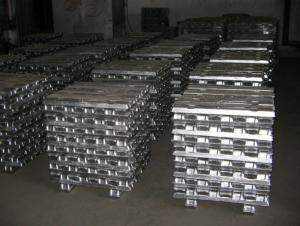Aluminum Ingot 99.9% with Best Price and High Purity
- Loading Port:
- China main port
- Payment Terms:
- TT OR LC
- Min Order Qty:
- 1000 m.t.
- Supply Capability:
- 10000 m.t./month
OKorder Service Pledge
OKorder Financial Service
You Might Also Like
Pure Aluminum Ingot Used for Industry
1.Structure of Aluminum Ingot Description
Aluminum Ingot is with the AL as the main chemical composition. Aluminum Ingot is used for industry,such as automobile,pinning and weaving,electron broadly and so on. Aluminum Ingot has the following advantages: easy control and operation, fast melting.
2.Main Features of the Aluminum Ingot
•High Purity
•Easy control and operation
•High strength
•Fast melting
•Competitive price
•Best Service
3. Aluminum Ingot Images
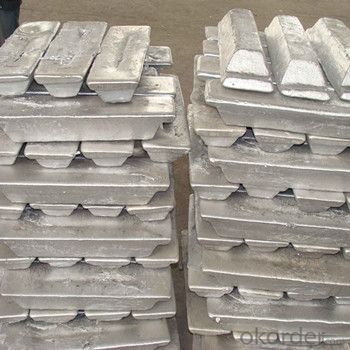

4. Aluminum Ingot Specification
Grade | Chemical Composition % | |||||||||
Al≥ | impurities ≤ | |||||||||
Si | Fe | Cu | Ga | Mg | Zn | Mn | others | Sum | ||
Al99.9 | 99.90 | 0.50 | 0.07 | 0.005 | 0.02 | 0.01 | 0.025 | - | 0.010 | 0.10 |
Al99.85 | 99.85 | 0.80 | 0.12 | 0.005 | 0.03 | 0.02 | 0.030 | - | 0.015 | 0.15 |
Al99.7 | 99.70 | 0.10 | 0.20 | 0.010 | 0.03 | 0.02 | 0.030 | - | 0.030 | 0.30 |
Al99.6 | 99.60 | 0.16 | 0.25 | 0.010 | 0.03 | 0.03 | 0.030 | - | 0.030 | 0.40 |
Al99.5 | 99.50 | 0.22 | 0.30 | 0.020 | 0.03 | 0.05 | 0.050 | - | 0.030 | 0.50 |
Al99.00 | 99.00 | 0.42 | 0.50 | 0.020 | 0.03 | 0.05 | 0.050 | - | 0.050 | 1.00 |
5.FAQ of Aluminum Ingot
We have organized several common questions for our clients,may help you sincerely:
①How about your company?
A world class manufacturer & supplier of castings forging in carbon steel and alloy steel,is one of the large-scale professional investment casting production bases in China,consisting of both casting foundry forging and machining factory. Annually more than 8000 tons Precision casting and forging parts are exported to markets in Europe,America and Japan. OEM casting and forging service available according to customer’s requirements.
②How to guarantee the quality of the products?
We have established the international advanced quality management system,every link from raw material to final product we have strict quality test;We resolutely put an end to unqualified products flowing into the market. At the same time, we will provide necessary follow-up service assurance.
③How long can we receive the product after purchase?
In the purchase of product within three working days, We will arrange the factory delivery as soon as possible. The pecific time of receiving is related to the state and position of customers.Commonly 7 to 10 working days can be served.
- Q: What is the impact of alloying elements on the properties of aluminum ingots?
- Alloying elements have a significant impact on the properties of aluminum ingots. By adding certain elements, such as copper, magnesium, or silicon, to aluminum, the resulting alloy can exhibit improved strength, hardness, corrosion resistance, and thermal conductivity. These alloying elements can also enhance the casting, machining, and welding characteristics of aluminum ingots, making them more versatile and suitable for a wide range of applications in industries like aerospace, automotive, and construction.
- Q: What are the advantages of using aluminum ingots in the production of medical devices?
- There are several advantages of using aluminum ingots in the production of medical devices. Firstly, aluminum is a lightweight metal, making it ideal for medical devices that need to be portable and easy to handle. It reduces the overall weight of the device, making it more comfortable for patients and easier for healthcare professionals to use. Secondly, aluminum has excellent corrosion resistance properties. This is crucial in medical devices as they often come into contact with various bodily fluids and chemicals. By using aluminum ingots, manufacturers can ensure that the medical devices will not corrode or degrade over time, thus increasing their lifespan and reliability. Additionally, aluminum is highly malleable and can be easily shaped and formed into intricate designs. This allows for the production of complex medical devices with precise specifications. The versatility of aluminum ingots enables the creation of devices that can fit various anatomical structures, ensuring a better fit and improved functionality for patients. Furthermore, aluminum is a non-toxic material and does not react with human tissues. It is biocompatible, meaning it can be safely used in medical devices that come into direct contact with the body, such as implants, surgical instruments, and prosthetics. Aluminum's biocompatibility reduces the risk of adverse reactions or complications for patients. Lastly, aluminum ingots are cost-effective compared to other metals commonly used in medical device production. The abundance of aluminum ore and its relatively low cost of extraction make it a more affordable option for manufacturers. This cost-effectiveness can lead to more accessible medical devices, benefiting patients and healthcare systems worldwide. In conclusion, the advantages of using aluminum ingots in the production of medical devices include their lightweight nature, excellent corrosion resistance, malleability, biocompatibility, and cost-effectiveness. These properties make aluminum a suitable choice for creating high-quality, durable, and safe medical devices.
- Q: How many tons of alumina for a ton of aluminum ingot, alumina and electrolytic aluminum what is the difference?
- Electrolytic aluminum is a metallic aluminum refined by electrolysis. It is an aluminum of high purity.
- Q: The mold is aluminum magnesium ingot foundry made it
- Now, most of them are made of resin bonded sand.
- Q: How are aluminum ingots used in the production of electrical connectors?
- Due to their excellent conductivity and lightweight properties, aluminum ingots are commonly used in the production of electrical connectors. Initially, the ingots are melted and cast into specific shapes, such as bars or rods, which are then further processed to form the connectors. One major advantage of aluminum ingots is their high electrical conductivity. Aluminum is an exceptional conductor of electricity, enabling efficient transmission of electrical signals in various applications. This makes it an ideal material for producing connectors that require the smooth flow of electricity without significant resistance or loss. Furthermore, aluminum ingots offer lightweight characteristics compared to other materials like copper. This lightweight property is particularly advantageous for electrical connectors as it facilitates easier installation, handling, and transportation. The reduced weight also helps minimize strain on electrical systems and devices. The production of electrical connectors involves melting the aluminum ingots and casting them into specific shapes using various casting techniques. These shapes can range from bars and rods to intricate designs, depending on the requirements of the connectors. The ingots then undergo further processing through machining, extrusion, or other shaping methods to achieve the desired dimensions and features. After shaping, the aluminum connectors undergo additional processes such as surface treatment or coating to enhance their performance and durability. This may involve plating the connectors with materials like silver or tin to improve conductivity or applying protective coatings to prevent corrosion. In summary, aluminum ingots are essential in the production of electrical connectors as they provide a reliable and efficient material that meets the demands of modern electrical systems. Their excellent conductivity, lightweight nature, and versatility make them the ideal choice for a wide range of electrical connector applications.
- Q: How can I make a pop top aluminum ingot?
- Production of miscellaneous aluminium ingots by mixing with other waste aluminum;A deoxidizer used in steelmaking;Production of aluminum: the waste cans in the rotary kiln for stripping paint processing, and then processing, production of low-grade aluminum powder.
- Q: How much is the power consumption to smelt a ton of aluminium ingot?
- Theoretically, 1 tons of aluminium ingots are melted down, consuming 500 degrees
- Q: What does aluminium ingot blacken because of temperature? Rain? Aluminium oxide? Iron salt?
- The humidity is contacted with the air and is oxidized. The aluminum ingot also contains trace amounts of other metal elements, which are also oxidized to black
- Q: How are aluminum ingots used in the production of window frames?
- Aluminum ingots are melted down and formed into extruded profiles, which are then cut and assembled to create window frames. The ingots provide the raw material necessary for the manufacturing process and ensure the frames are lightweight, durable, and corrosion-resistant.
- Q: How to add zinc when producing aluminium ingot?
- If you want to use the post deployment steps are as follows: first, a certain number of scrap melting - Sampling components -- assuming you require zinc component is just 2, if the component is not enough, add an equal amount of zinc calculation, the calculation method is very simple
Send your message to us
Aluminum Ingot 99.9% with Best Price and High Purity
- Loading Port:
- China main port
- Payment Terms:
- TT OR LC
- Min Order Qty:
- 1000 m.t.
- Supply Capability:
- 10000 m.t./month
OKorder Service Pledge
OKorder Financial Service
Similar products
Hot products
Hot Searches
Related keywords
